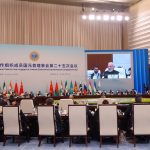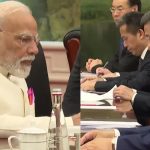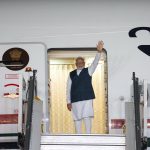 New Beginnings, New Hopes and New Horizons.
New Beginnings, New Hopes and New Horizons.
These expressions may sound like rhetorical hyperboles to some, but summarise the essence of the current transformational moment in relations between India and Sri Lanka, which has acquired a new bounce and energy after the formation of the new government in Colombo in January this year.
Four Visits, New Horizons
In barely three months, there would have been four high-profile interactions, starting from the visit of Sri Lankan foreign minister to India, followed by the February 15-18 visit of President Maithripala Sirisena to New Delhi. President Sirisena’s choice of India as his first overseas destination sent a clear message that the India-Lanka relations have moved into the fast lane, and will go on to acquire more strategic weight and economic substance in days to come.
 Mr Sirisena’s visit was followed by India’s External Affairs Minister Sushma Swaraj’s trip to the island nation. Minister Swaraj’s wide-ranging interactions have set the stage for the visit by Prime Minister Narendra Modi to Sri Lanka on March 13-14. The symbolism and importance of Mr Modi’s visit is clear from the fact that this will be the first standalone bilateral visit by an Indian prime minister to the island country after Rajiv Gandhi’s trip in 1987.
Mr Sirisena’s visit was followed by India’s External Affairs Minister Sushma Swaraj’s trip to the island nation. Minister Swaraj’s wide-ranging interactions have set the stage for the visit by Prime Minister Narendra Modi to Sri Lanka on March 13-14. The symbolism and importance of Mr Modi’s visit is clear from the fact that this will be the first standalone bilateral visit by an Indian prime minister to the island country after Rajiv Gandhi’s trip in 1987.
Modi’s Visit: What’s on Agenda?
All eyes in the region will be on the meeting between Mr Modi and Mr Sirisena as they unveil an ambitious roadmap for multi-pronged acceleration of bilateral ties across diverse areas, including trade and investment, development cooperation, defence cooperation and reconstruction of the island nation.
The talks are expected to focus on the political reconciliation process in Sri Lanka and finding a lasting solution to addressing the aspirations of the Sri Lankan Tamils within the framework of the constitution of the country. The issue will also be in focus when Prime Minister Modi visits Jaffna, home to a large population of Sri Lankan Tamils, and Mr Modi’s meetings with the leaders and representatives of the Tamil National Alliance and other political leaders across the spectrum in Colombo. “Politically, I think we clearly want to promote and encourage the reconciliation process, support democracy and reform, and we do want to expand our people-to-people contacts including tourism, travel between the two countries,” India’s Foreign Secretary S. Jaishankar said while outlining broad themes that will frame the prime minister’s path-breaking visit to India’s key island neighbour.
The fishermen issue should be among key issues on the agenda as this has strong political ramifications in both countries. The two sides will be looking to resolve the issue in a constructive and humanitarian manner.
The highlight of the trip will be Prime Minister Modi’s address to the Sri Lankan parliament, which will flag off a long-term vision for India-Sri Lanka relations and a soaring vision of New Delhi’s view of the Indian Ocean as a zone of peace and opportunity.
Development Diplomacy
Developmental cooperation forms the key pillar of the burgeoning India-Sri Lanka partnership, and will see a marked upswing during the prime ministerial trip. Significantly, this is the first visit by an Indian prime minister to Jaffna, and fittingly, the focus will be on the transformational aspect of India’s developmental diplomacy. India had pledged to build 50,000 houses in Sri Lanka – 42,000 in the Northern Province, 4,000 in the Eastern Province, and 4,000 in the Central and Uva Provinces. This is fast-track development diplomacy, as within a span of barely three years, India has been able to build 27,000 houses. The prime minister would be formally handing over in Jaffna some of these 27,000 houses to those displaced by the civilian war, but are now brimming with hope to refashion their life anew. Away from the glare of media hype and headlines, India’s development aid and soft loans have carved a new narrative of renaissance among people who were bereft of hope not too long ago.
Most of India’s line of credit of $800 million have been channelized in transforming and renovating the railways sector and connectivity projects, and the results are for there for all to see. The southern line, which was battered by the tsunami from Kalutara-Galle-Matar, has now been restored and resurrected. Similarly, the northern line from Omanthai to Kankesanthurai, the northwestern line from Talaimannar to Medawachchiya, the rehabilitation of KKS harbour and the Palali runway are shining examples of India’s untiring commitment to do its bit to stimulate the resurgence of a neighbouring country that is scripting its destiny afresh. When Prime Minister Modi unveils a plaque inaugurating the Talaimannar pier railway station, one can expect radiant beaming smiles all around.
Economic Diplomacy
Economically, the two countries will be looking to build on their over $5 billion bilateral trade and raise the bar. India is expected to unveil some incentives that will enable Sri Lanka to expand its exports, thereby reducing the trust deficit with its larger neighbour. The signing of the FTA in 2002 was a game-changer of sorts. India is now among the four largest overall investors in Sri Lanka with cumulative investments over US$ 800 million. In 2013, Indian investment into Sri Lanka amounted to US$ 50.52 million.
New Energy
Energy security has emerged as a key aspect of the evolving India-Sri Lanka relations, which is foraying into new areas. The two countries signed a pact on cooperation in peaceful uses of civilian nuclear energy during the visit of President Sirisena to New Delhi in February. Mr Modi’s visit will seek to push the envelope, and could see visible progress on India building a thermal power plant in Sampur, close to Trincomalee.
Cultural Diplomacy: People’s Power
Besides strategic and economic facets, the prime ministerial trip will cohere culture and civilizational bonds that binds the two fraternal neighbours. Buddhist spiritual bonds will be highlighted when Mr Modi visits the ancient heritage city of Anuradhapura and prays at the Mahabodhi Society in Colombo. He will also be inaugurating Jaffna Culture Centre that will underline cultural synergy between the two nations. People-to-people bonds keep India-Sri Lanka relations humming. Facts speak for themselves: there are 118 weekly flights. We are actually the largest source of tourists to Sri Lanka. Around 200,000 Indians visit Sri Lanka every year. And about 260,000 Sri Lankans visit India every year.
The Road Ahead
From building houses, schools and hospitals to constructing roads, airports, and ports, India has been proactively engaged with reconstruction and resurgence of the neighbouring country.
Geography, History, and Culture. Business, Buddhism and Strategy. The relations between India and Sri Lanka are truly multifarious, blending diverse elements, and driven by enduring bonds of friendship and fraternal empathy between the people of India and Sri Lanka. With bilateral trade on an upswing, the focus will be on renewing deep connections of the mind and heart. With both countries looking at each other as a narrative of opportunity, the India-Sri Lanka relations have entered a fast-track phase. With the new government in Colombo upbeat about dovetailing the India story to that of the island’s unfolding resurgence, the sky is virtually the limit for India-Sri Lanka relations.
Expect new doors to open up in this time-tested relationship.
( Manish Chand is Editor-in-Chief of India Writes Network, www.indiawrites.org, an e-magazine-journal focused on international affairs and the India Story).
Manish Chand is Editor-in-Chief of India Writes Network, www.indiawrites.org, an e-magazine-journal focused on international affairs and the India Story).
–This article was first published in www.mea.gov.in
Author Profile

- Manish Chand is Founder and Editor-in-Chief of India Writes Network (www.indiawrites.org) and India and World, a pioneering magazine focused on international affairs. He is CEO, Centre for Global India Insights, an India-based think tank focused on global affairs.
Latest entries
 India and the WorldOctober 2, 2025With US frowning, India to host Putin in December
India and the WorldOctober 2, 2025With US frowning, India to host Putin in December India and the WorldSeptember 1, 2025Tianjin boost for India: SCO rises against cross-border terror
India and the WorldSeptember 1, 2025Tianjin boost for India: SCO rises against cross-border terror India and the WorldAugust 31, 2025Message from Modi-Xi meeting: It’s the right choice to engage and be friends
India and the WorldAugust 31, 2025Message from Modi-Xi meeting: It’s the right choice to engage and be friends DiplomacyAugust 29, 2025Ahead of China visit, Modi eyes Japan opportunity
DiplomacyAugust 29, 2025Ahead of China visit, Modi eyes Japan opportunity







